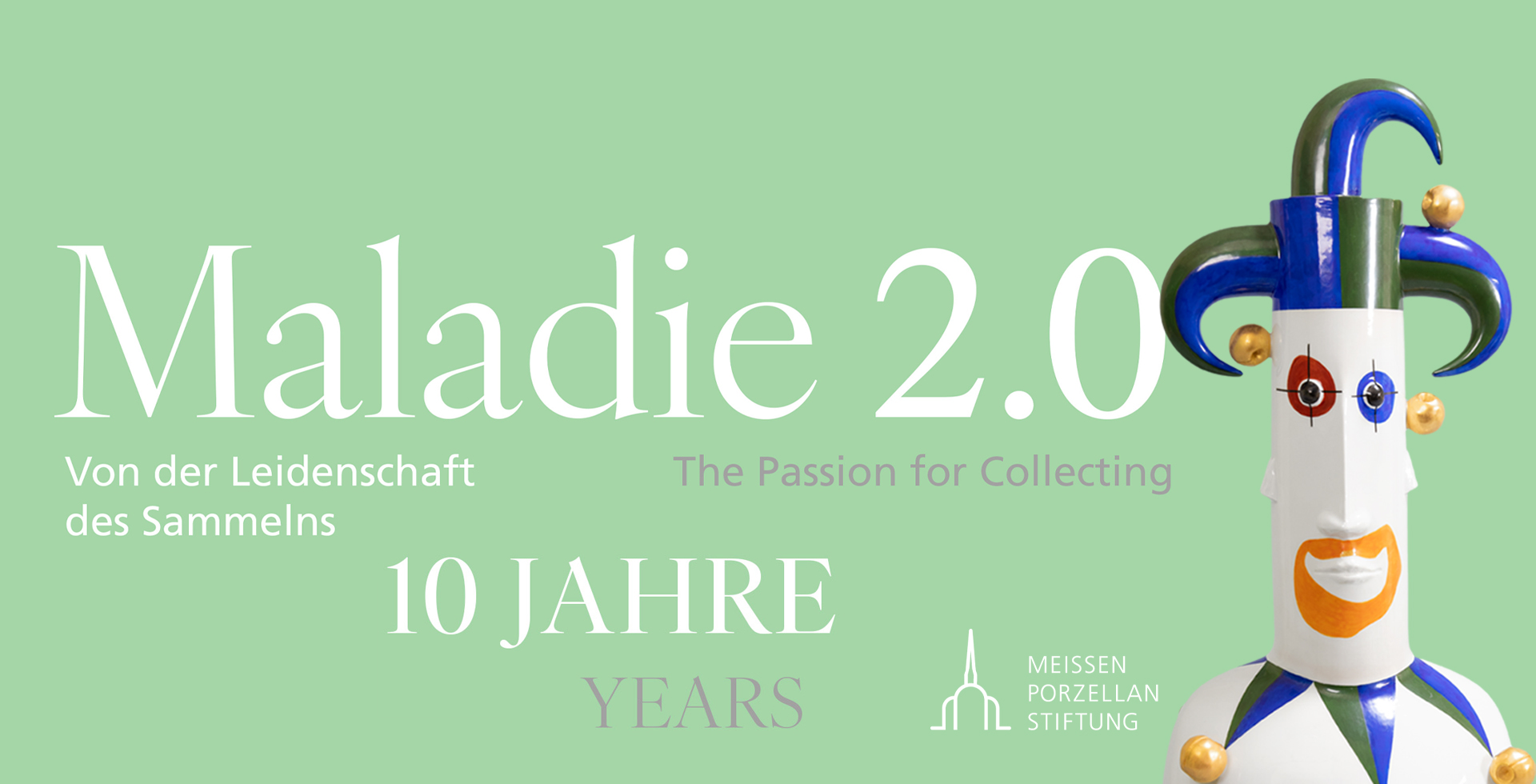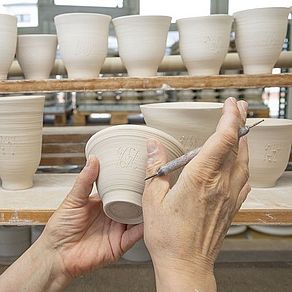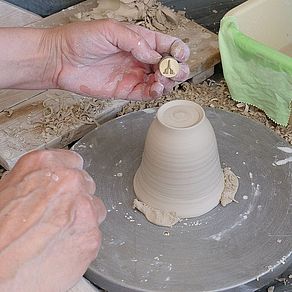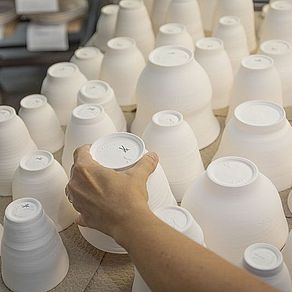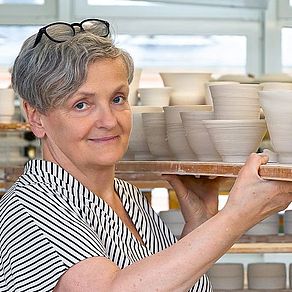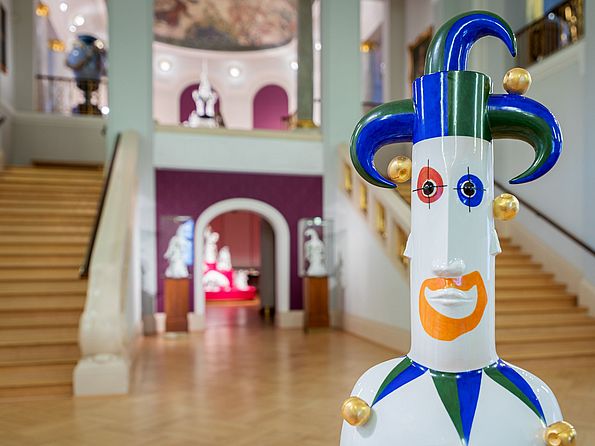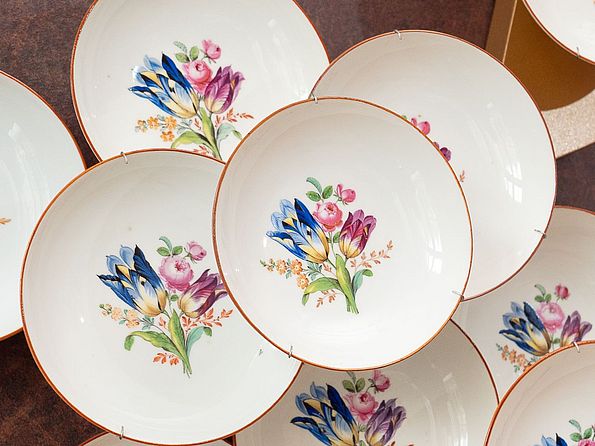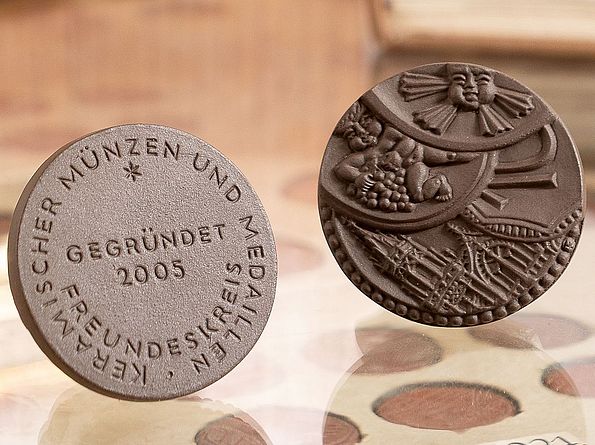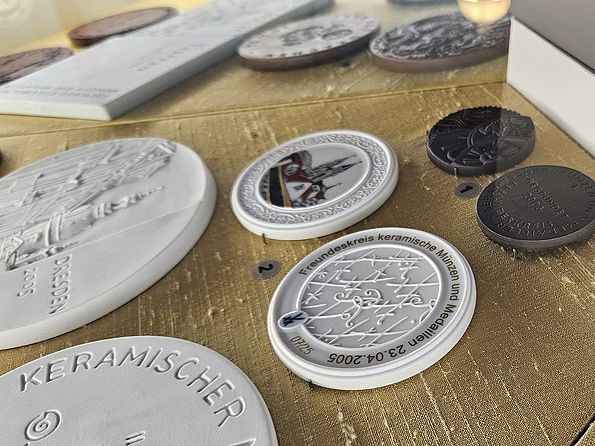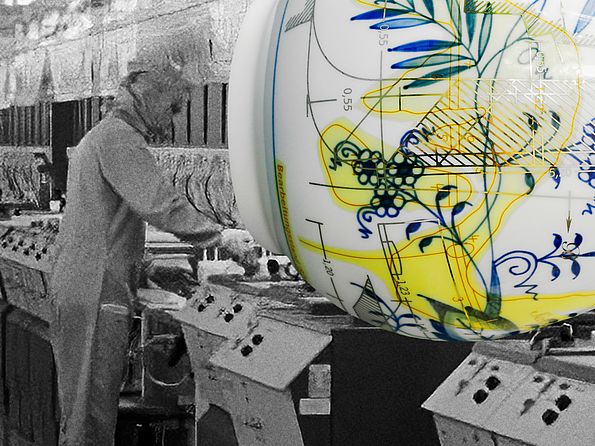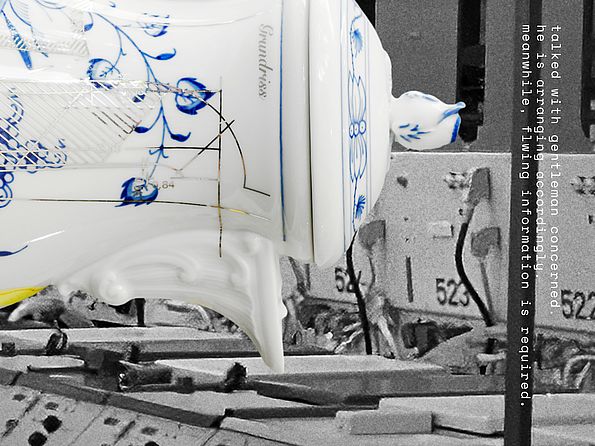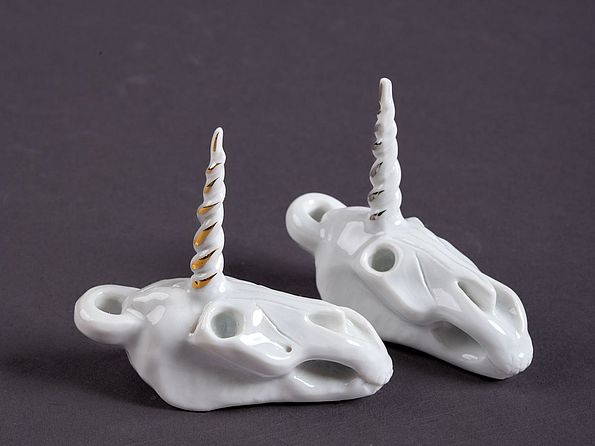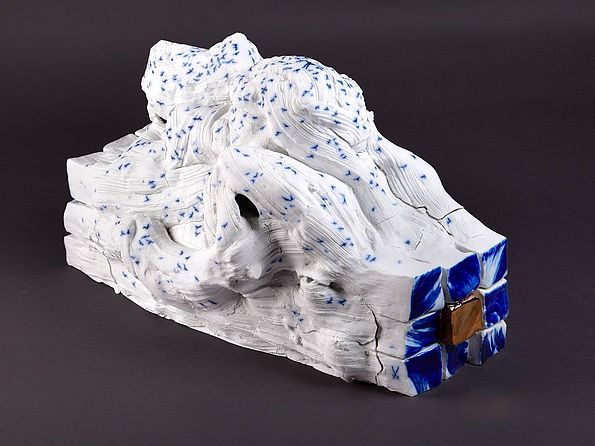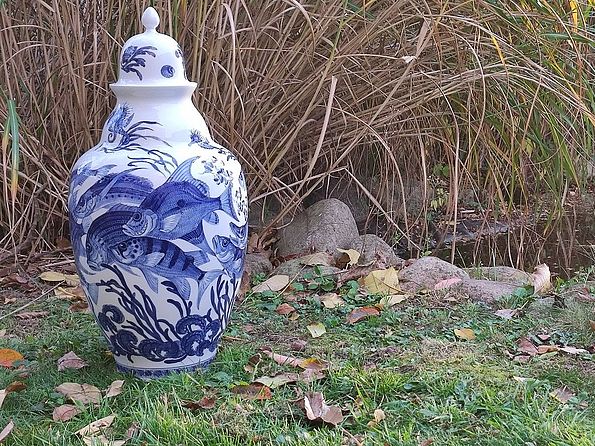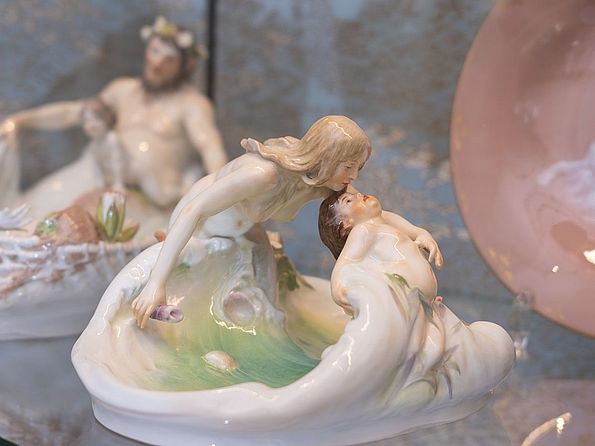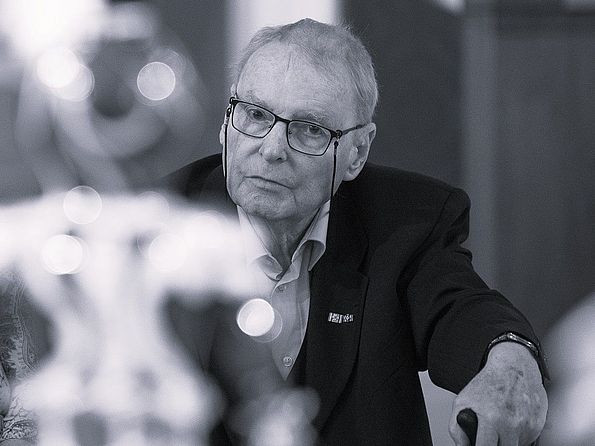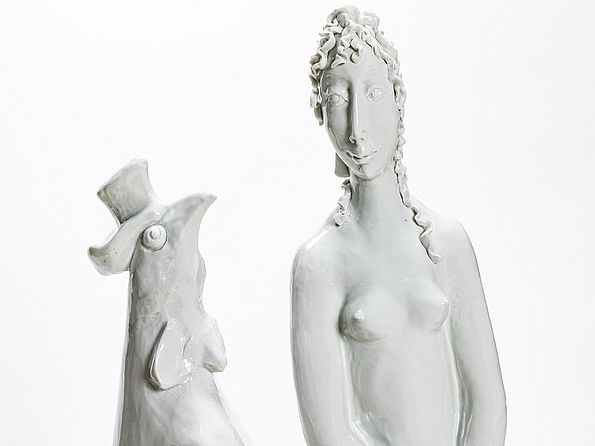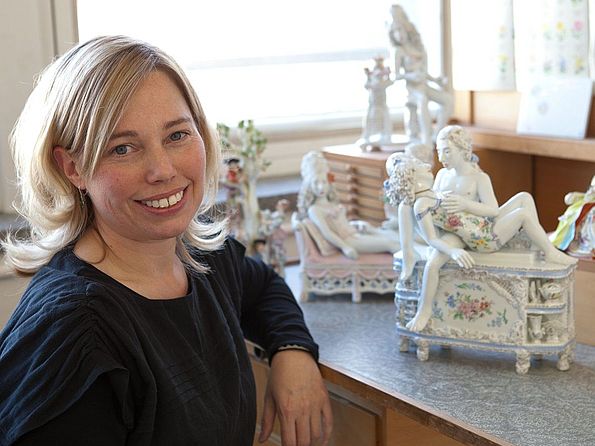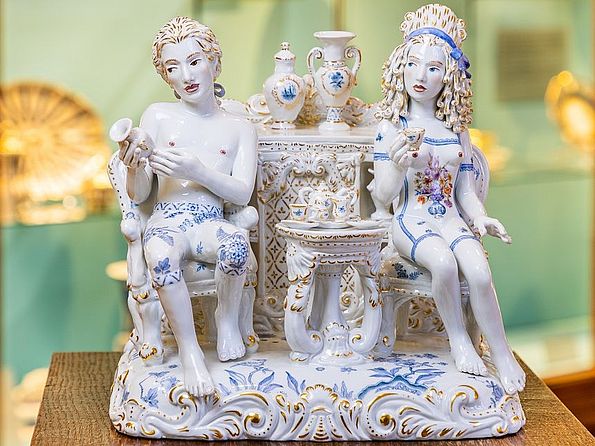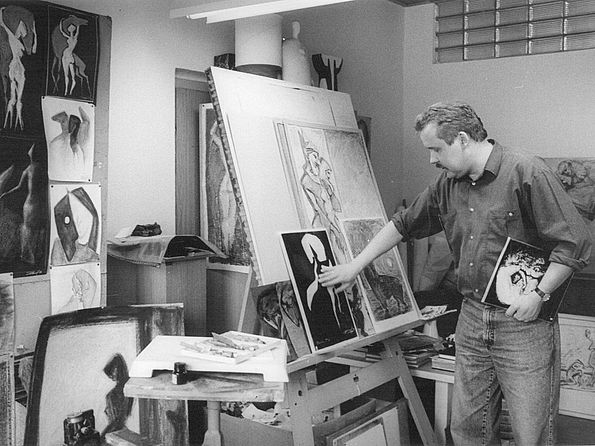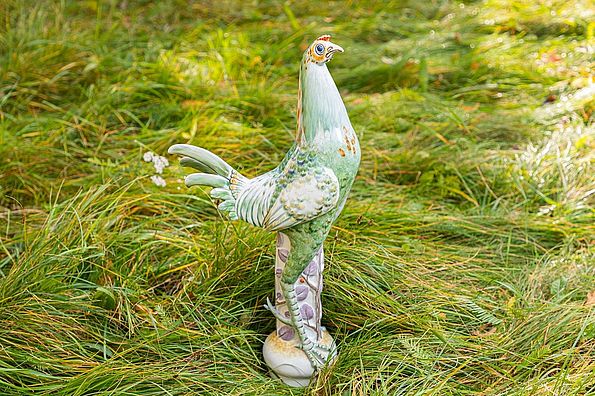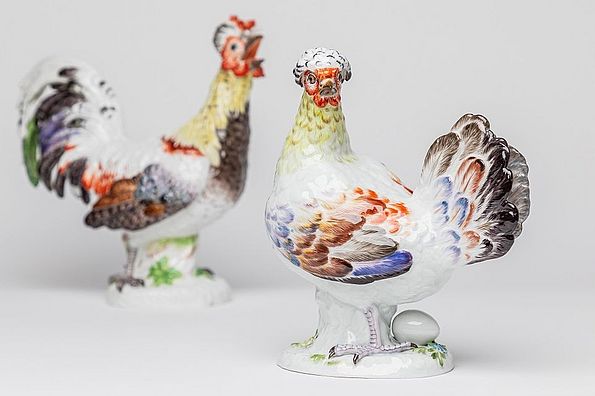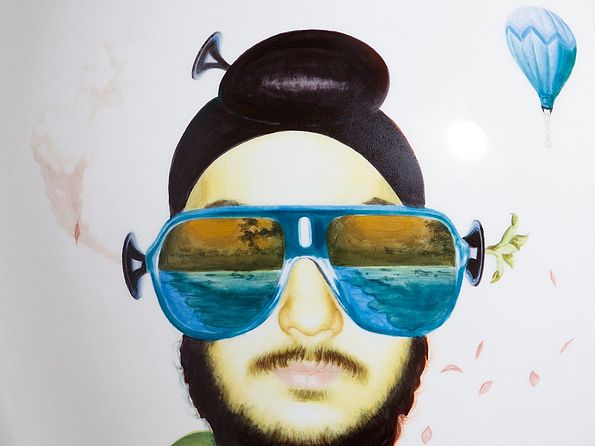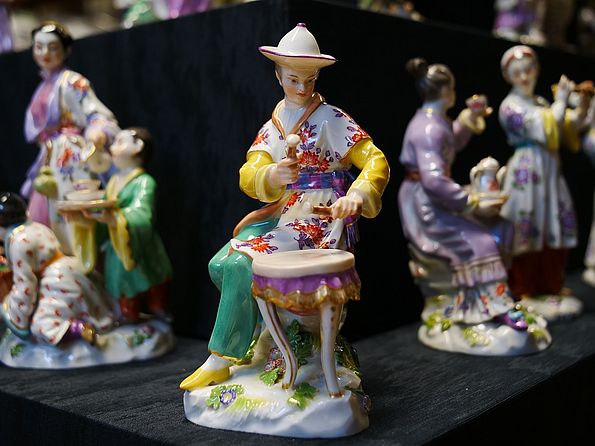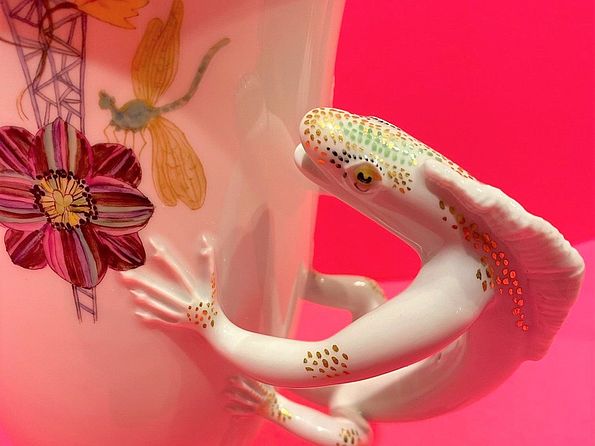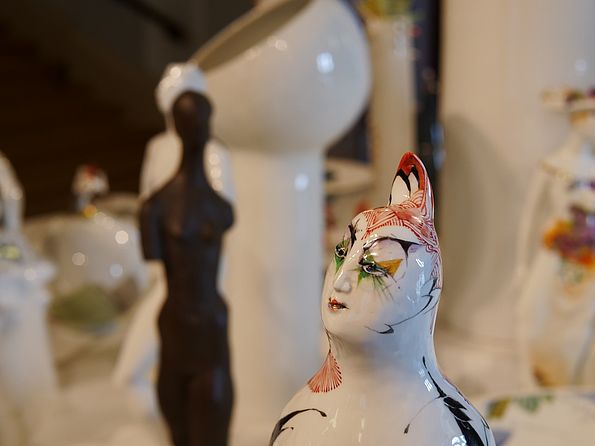Exhibitions
2025
ONE MILLION by Uli Aigner
Throwing a million porcelain pots with her own hands by the time she dies – that’s the idea behind ONE MILLION by Uli Aigner. The artist uses a piece of moist earth to create a basic commodity that can be used anywhere in the world. Each item is given an engraved number indicating the exact order in which it was made and then programmed into a digital world map. In this way, Uli Aigner forges a link between her own work and the entire chain of human evolution.
Sixty of her vessels were modelled in MEISSEN, and 50 of these can now be purchased. They each bear a chronological ONE MILLION number and the Manufactory’s crossed swords in blue. Thus, MEISSEN, too, has been written into the ONE MILLION narrative.
Uli Aigner views porcelain as a political material and a storage medium. It tells tales of a colonial era in which “white gold” made its way from China to the royal courts of Europe. The story of European porcelain began in MEISSEN.
Ms Aigner’s aim with ONE MILLION is to take the story forward into the present and future. Archaeological finds of ceramics enable us to piece together how primitive peoples lived and what they knew. ONE MILLION constitutes an archaeology of the present in that each of its vessels is also recorded in a digital dataset. The upshot is a transgenerational art project that synchronises age-old pottery techniques with the very latest in digital technologies.
Maladie 2.0 The passion for collecting
Meissen Porcelain Foundation Ten Years On
Exhibition in the Meissen Porcelain Foundation Museum, 21 March 2025–22 February 2026
Joys of Collecting. The Meissen Porcelain Foundation was established in late 2014 and entered service in 2015. It preserves Meissen porcelain as a cultural asset. One of its tasks involves looking after the Meissen Porcelain Manufactory’s historical collection.
The Manufactory’s founder Augustus the Strong referred to his passion for porcelain as a “maladie”. That literally means “illness” but merely reflects his boundless longing for the precious white gold. Generations of collectors have shared his enthralment ever since – as have active artists. Their porcelains document the invention, making and collecting of these delightful white objects. Manufactory staff in porcelain provide insights into the art-handiwork they incorporate. Jubilant collectors nurture their treasures. Artists play around with the concept of porcelain and in the process transform centuries-old work resources into contemporary porcelain art.
The exhibition sheds light on the Foundation’s work whilst also showcasing Meissen porcelains given over to the subject of collecting.
20 years of the Circle of Friends of Ceramic Coins and Medals
Presentation of medal editions
12 April-15 June 2025
The Circle of Friends of Ceramic Coins and Medals was founded in April 2005. It is an association of people interested in coins and medals made of ceramic material. The founding members have set themselves a variety of goals and tasks: They deepen and disseminate their knowledge, exchange experiences and collectors' material. They organise excursions and specialist lectures. They build up a network - with other organisations, societies, museums and clubs that are involved in their field of collecting. The circle of friends works together with manufacturers and artists and publishes its own medal editions. The Friends issue their own publications on a wide variety of manufacturers and specialised topics relating to ceramic medallic art. They share their passion with an interested public in exhibitions or exhibition participations.
The presentation in the Museum of the Meissen Porcelain Foundation shows the medal editions of the Circle of Friends and presents their work in more detail. It comprises more than 40 objects and is included in admission to the World of Meissen.
2024
Project Zwiebelmuster
Antye Guenther's Science Fiction in Porcelain
November 8, 2024 to March 2, 2025
The Meissen Porcelain Manufactory has been producing its famous Onion Pattern for almost three hundred years now. The cobalt-blue decoration evolved from Chinese designs and has remained a favourite for banquets and the home to the present day. Artist Antye Guenther guides the pattern through occasionally crazy embroilments between the GDR and Japan. Taking the GDR of the 1970s and 1980s as her cue, she tracks the pattern down in scenarios ranging from its being used as a means of payment in the illegal transfer of technology to the famous Dresden Zwinger reconstructed in Japan’s porcelain capital Arita. The artist narrates a science fiction story in which she enlists the Onion Pattern’s services as a clandestine storage medium for highly sensitive information. She devised new porcelains for her “secret agents” in cooperation with the Manufactory.
Wood, Bones & White Gold
Objects in Meissen Porcelain by Helena Sekot, Philsoo Heo and David Torres
March 15 - October 20, 2024
Budding artistic creatives have put unusual projects to effect in the studios of the heritage-rich Meissen Porcelain Manufactory. They are not new to working with ceramic materials, having already furnished ample evidence of their talent in courses of specialised study and actual works. They all won Richard Bampi Prizes in 2022. During subsequent residencies spent in the Meissen Manufactory’s studios, they got to know how the place ticks and exploited its great potential for their own creations. The exhibition covers works by Helena Sekot, Philsoo Heo and David Torres and provides insights into the creative processes involved.
Helena Sekot adapts typical Meissen shapes in images that beckon responses from their beholders. Philsoo Heo derives inspiration from wood. He morphs its fissured surface into bulkily elegant porcelain. Large-format sculptures by the Colombian David Torres reference the history of Meissen Porcelain whilst also addressing stereotypes; “white gold” may stand for porcelain in Germany but in Colombia it’s a byword for cocaine.
2023
All is in flux. Water & Meissen Porcelain
March 16, 2023 until February 25, 2024
Water is the basis of all life. As one of the four elements of matter, it also inspired the Meissen Manufactory to model the likes of bathers taking a dip, mythological aquatic beings or creatures from the seas. Patterns painted on porcelain have included pond landscapes, scenes of maritime commerce and individuals fishing. Water is emblematic of sources and origins, of motion and purity. Tableware shapes incorporate aquatic motifs in the form, for instance, of sea-shells and relief-moulded waves. The exhibition covers three centuries of Meissen porcelains.
In memoriam Peter Strang
January 23 to February 28, 2023
Joint exhibition of Meissen Porcelain Manufactory and Meissen Porcelain Foundation
The modeller Peter Strang had a decisive impact on artistic developments at the Meissen Porcelain Manufactory in the second half of the 20th century. He joined the Manufactory as an apprentice in 1950 and, following academic studies, was active from 1960 in the Artistic Development Collective, where he authored various series of figurines, items of figural tableware, murals and, from 1977 onwards, a number of one-offs in Meissen porcelain. Peter Strang held the post of Artistic Director at the Manufactory from 1993 until he retired in 2001. Peter Strang passed away at the age of 86 on December 21st, 2022. Meissen Porcelain Foundation and Meissen Porcelain Manufactory commemorate the artist in this joint exhibition.
A Great Passion. Chris Antemann and Meissen, the first ten years
July 15, 2022- February 26, 2023
The first collection of Meissen porcelains by the US artist Chris Antemann appeared in 2012. She has since designed a wealth of table centres, sensuous figurines, candleholders and vase objects all bearing her characteristic imprint. The exhibition points up the links between Antemann’s work and the Manufactory’s own history whilst also demonstrating the contribution to modernity that her formal vocabulary makes.
On Jörg Danielczyk’s 70th birthday
June, 2-July 3, 2022
The artist Jörg Danielczyk spent almost half a century working for the Meissen Manufactory. Having trained as a modeller and graduated as a sculptor and designer, he fashioned a plethora of figurines, murals, tableware services, medallions and one-offs in porcelain. He defined Meissen’s formal idiom as artistic head of modelling and designer-in-chief and made a name for himself with work for clients both private and public. He retired in 2018. Jörg Danielczyk celebrates his 70th birthday on 28 June 2022. This special exhibition honours the artist by sampling his porcelain creations.
Chickens!
March 17 to May 29, 2022
Chickens are the most common farm animal of mankind. Statistically, there is one chicken to every person in the world. Hence, it is no surprise these animals have always played a role in Meissen porcelain design. Poultry-shaped tureens set out on royal dining tables provided a preview of the delicacies contained within. Figure groups with chickens, typically portraying life on a village farm, were beloved forms of table decoration at court. Chickens are also used in figure groups to symbolise either the dawn or a fighting spirit. Our latest theme exhibition sheds light on the history of Meissen chicken figurines from early in the 18th century to the present day.
Pining For the Far-Away. Touring the World in Porcelain
May 2021-February 2022
There is a long tradition of pining for the far-away in European porcelain. The first models artists at Meissen created three centuries ago were of Chinese, Japanese and Persian citizens. At a time when travel was far more irksome than it is today, Europe’s princes liked to surround themselves with images of distant civilisations. Allegories of continents likewise lent their owners an aura of cosmopolitan grandeur. People from foreign lands continued to inspire porcelain modellers at the Meissen Manufactory thereafter, too. Artists in the 19th and 20 centuries were now no longer reliant on travel reports, however, producing their figurines on the basis of what they witnessed on their own travels. They modelled the indigenous peoples of America just as they did their Polish or Dutch neighbours.
Activation required
Clicking this video allows YouTube videos to be shown on this website in future. We would, however, like to point out that data are transmitted to YouTube following activation. You can permanently activate the running of videos in this way or else permanently disable the function in our Data Privacy Statement.
During the GDR period, models were made of citizens from other Eastern Bloc states. The Manufactory’s artists additionally strove to embrace the far-away through the realm of the fairy-tale, moreover. The fabled Orient was recreated in figures from the tales of the Arabian Nights. Indian artist duo Thukral & Tagra brought the far-away to Meissen porcelain in a new way early in the 21st century with their Somnium Genero and Dominus Aeries Flutter series. Conspicuous shapes, exotic colour schemes and fanciful scenes adorn their objects whilst also acting as an antidote to pining for places we are unable to visit at present on account of the pandemic.
Sweet Fruit & Blue Waves. Meissen Porcelain by Gudrun Gaube, Silvia Klöde and Sabine Wachs
8 September - 31 October 2021
The artists Gudrun Gaube, Silvia Klöde and Sabine Wachs have been designing porcelains for series production since the 1980s, as well as producing several one-offs in Meissen porcelain. The Meissen Porcelain Foundation is now showing 40 or so works by these artists in a special exhibition.
Gudrun Gaube (*1961) joined the Meissen Manufactory in 1990 as a pattern designer. She authored decorative schemes for tableware services and figurines alike. Gaube’s painting is driven by loving attention to detail. She derives inspiration from Nature, though traditional Asian patterns and calligraphy also play a part in her work. Her one-offs additionally take her into the realm of modelling. Gaube has freelanced for several factories since 2011. She is currently working on one-offs in Meissen porcelain. Gudrun Gaube turned 60 years of age on 8 September 2021.
Silvia Klöde (*1956) has studied virtually every aspect of the porcelain crafting trade. She trained as a modeller and underwent a course of studies in Art before returning to the Manufactory as a graduate sculptor in 1983 and initially specialised in designing medals. Portrayals of women form the main focus of the figures she designs. The artist has also regularly worked with the reddish-
brown material known as Böttger Stoneware as well as designing vessels. She has worked as a freelance artist since 2011. Silvia Klöde turns 65 years of age on 15 October 2021.
Activation required
Clicking this video allows YouTube videos to be shown on this website in future. We would, however, like to point out that data are transmitted to YouTube following activation. You can permanently activate the running of videos in this way or else permanently disable the function in our Data Privacy Statement.
Sabine Wachs (*1960) designed numerous vessels, vases and extensive tableware services from 1985 onwards. She was designer-in-chief at Meissen for many years. She conceived the “Waves” tableware shape launched in 1996. 25 years on, Waves has long since become a classic of Meissen dining culture. Sabine Wachs has developed patterns and created architectural wall designs, amongst them a mural in porcelain and photo-concrete produced for the front wall of the Meissen Porcelain Museum in 2004/5. Sabine Wachs has worked on a freelance basis in her own porcelain studio since 2011. Here she designs one-offs, bespoke porcelain interiors and products for various porcelain factories.
Activation required
Clicking this video allows YouTube videos to be shown on this website in future. We would, however, like to point out that data are transmitted to YouTube following activation. You can permanently activate the running of videos in this way or else permanently disable the function in our Data Privacy Statement.
Peter Strang – One-offs in porcelain
The modeller Peter Strang had a decisive impact on artistic developments at the Meissen Porcelain Manufactory in the second half of the 20th century. He joined the Manufactory as an apprentice in 1950 and, following academic studies, was active from 1960 in the Artistic Development Collective, where he authored various series of figurines, items of figural tableware, murals and, from 1977 onwards, a number of one-offs in Meissen porcelain. Peter Strang held the post of Artistic Director at the Manufactory from 1993 until he retired in 2001. Enthusiasts and collectors the world over greatly relish the series and one-offs Strang creates. This passionate ceramist still regularly works on artistic projects in Meissen porcelain today.
Activation required
Clicking this video allows YouTube videos to be shown on this website in future. We would, however, like to point out that data are transmitted to YouTube following activation. You can permanently activate the running of videos in this way or else permanently disable the function in our Data Privacy Statement.
Crossed Swords, Charm and Diplomacy. On the tenth anniversary of Ludwig Zepner’s death
The modeller Ludwig Zepner (1931-2010) spent more than 50 years working for the Meissen State Porcelain Manufactory. From 1960 onwards, he oversaw the switch to a more modern style of design at Meissen in collaboration with Peter Strang, Heinz Werner and, later on, Rudi Stolle and Volkmar Bretschneider. Zepner was officially appointed head of the “Artistic Development Collective”, which had initially been a loose grouping of artists, in 1966, and held this office until 1990. A special exhibition marking the tenth anniversary of the porcelain modeller’s death can continue to be attended on a virtual basis for the foreseeable future.
Activation required
Clicking this video allows YouTube videos to be shown on this website in future. We would, however, like to point out that data are transmitted to YouTube following activation. You can permanently activate the running of videos in this way or else permanently disable the function in our Data Privacy Statement.
Paul Scheurich. Porcelain modeller, draughtsman, graphic artist
Paul Scheurich (*1883 New York, †1945 Brandenburg) was one of the most important porcelain modellers in the first half of the 20th century. Our theme exhibition marking the 75th anniversary of his death delves into his life and work. Scheurich’s porcelain designs for Meissen and other German manufactories, augmented by rare bronze statues, drawings, illustrations and commercial art by the artist, yield a multifaceted portrait of the man.
